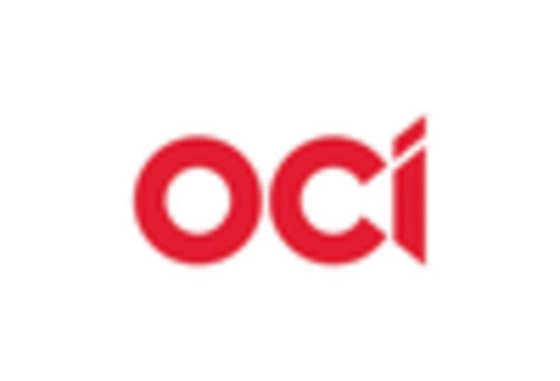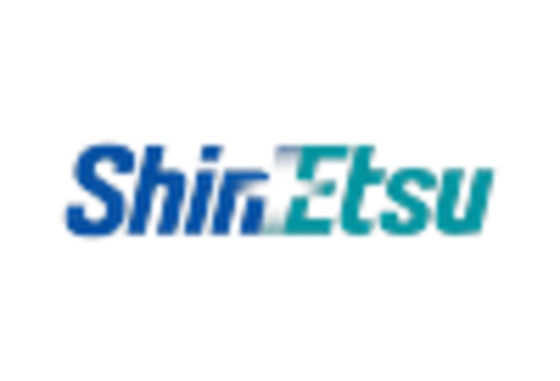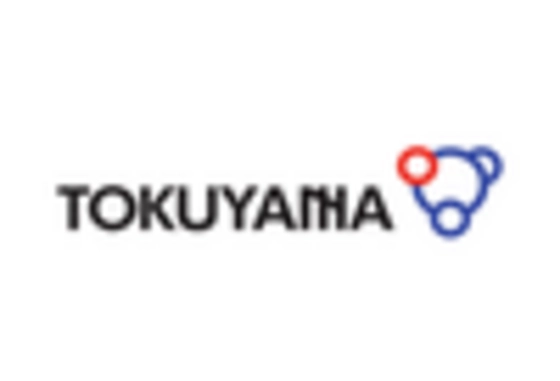Increasing Demand for Solar Cells
The Trichlorosilane Market is experiencing a notable surge in demand due to the increasing production of solar cells. As the world shifts towards renewable energy sources, solar power has emerged as a leading alternative. Trichlorosilane Market is a critical precursor in the manufacturing of polysilicon, which is essential for solar cell production. Recent data indicates that the solar energy sector is projected to grow at a compound annual growth rate of over 20% in the coming years. This growth is likely to drive the demand for Trichlorosilane Market, as manufacturers seek to meet the rising needs of solar cell production. Consequently, the Trichlorosilane Market is poised for expansion, as it aligns with global energy trends and sustainability goals.
Expansion of Semiconductor Industry
The Trichlorosilane Market is significantly influenced by the expansion of the semiconductor industry. As technology advances, the demand for high-purity silicon for semiconductor applications continues to rise. Trichlorosilane Market serves as a vital source for producing high-quality silicon wafers, which are essential components in electronic devices. Recent statistics suggest that the semiconductor market is expected to reach a valuation of over 500 billion USD by 2026, indicating a robust growth trajectory. This expansion is likely to bolster the Trichlorosilane Market, as manufacturers ramp up production to meet the increasing requirements of the semiconductor sector. The interplay between these industries suggests a mutually beneficial relationship that could enhance market dynamics.
Regulatory Support for Clean Energy
The Trichlorosilane Market is benefiting from increasing regulatory support for clean energy initiatives. Governments worldwide are implementing policies aimed at reducing carbon emissions and promoting renewable energy sources. This regulatory environment is fostering investments in solar energy and other clean technologies, which in turn drives the demand for Trichlorosilane Market as a key material in solar cell production. Recent legislative measures indicate a commitment to achieving net-zero emissions by mid-century, which could further enhance the market for Trichlorosilane Market. As the industry adapts to these regulations, it is likely to see a surge in demand, positioning the Trichlorosilane Market favorably in the context of global energy transitions.
Growth in Electric Vehicle Production
The Trichlorosilane Market is also influenced by the growth in electric vehicle (EV) production. As the automotive industry shifts towards electrification, the demand for advanced materials, including high-purity silicon, is increasing. Trichlorosilane Market is essential for producing silicon-based components used in EV batteries and power electronics. Recent projections suggest that the electric vehicle market could exceed 30 million units sold annually by 2030, indicating a substantial increase in demand for related materials. This trend is likely to create new opportunities for the Trichlorosilane Market, as manufacturers seek to supply the necessary materials for the burgeoning EV sector.
Technological Advancements in Production
Technological advancements in the production processes of Trichlorosilane Market are playing a pivotal role in shaping the Trichlorosilane Market. Innovations in manufacturing techniques, such as improved purification methods and more efficient reactors, are enhancing the quality and yield of Trichlorosilane Market. These advancements not only reduce production costs but also minimize environmental impact, aligning with global sustainability initiatives. As companies adopt these new technologies, the overall efficiency of Trichlorosilane Market production is likely to improve, potentially leading to a decrease in market prices. This could stimulate demand across various sectors, including electronics and renewable energy, thereby fostering growth within the Trichlorosilane Market.
















Leave a Comment